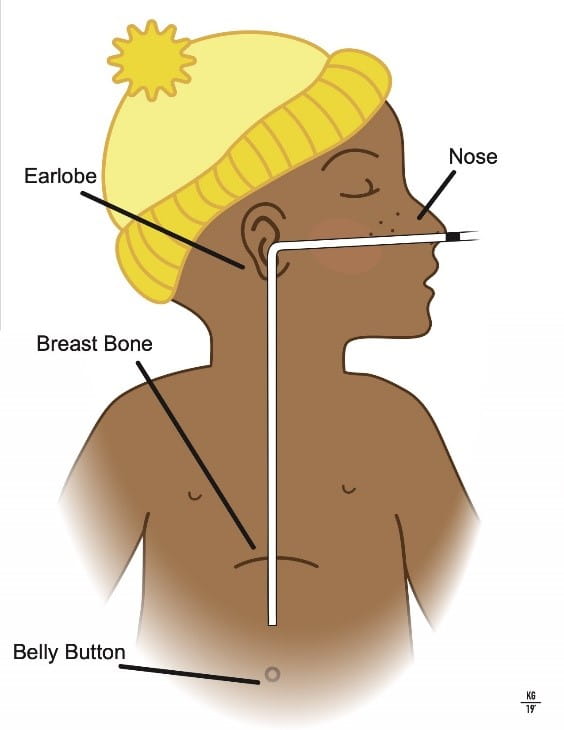What is Nasogastric Tube Gravity Bolus Feeding?

A nasogastric (NG) tube is a thin, soft tube that passes through the nose and into the stomach. The NG tube allows your child to get the nutrition, fluids or medications they need. NG tube training sessions are needed for all patients at home with a feeding tube.
Make sure the NG tube is in the right place:
- Wash your hands with soap and water.
- Check that the NG tube is in the right place:
- Measure the external length of the tube and check that this has not changed.
- External length = measurement of feeding tube from nostril to base of the hub OR check the mark on the NG tube that was drawn on the NG tube when the tube was placed, making sure it is right next to the nostril.
- Connect a small enteral syringe to the end of the NG tube and pull back to get stomach contents.
- Do not return the stomach contents back in the tube.
- Flush the NG tube with 3-5 mL of water.
- If you are unable to remove the stomach contents, remove the syringe, close the cover over the end of the tube, and place your child on their left side. After 10 minutes, repeat the attempt to pull back stomach contents into a syringe.
- Do not return the stomach contents back in the tube.
- Flush the NG tube with 3-5 mL of water.
- If you are unable to remove stomach contents, remove the NG tube and reinsert tube (if you have been taught how to do so).
Give a feeding:
- Wash your hands with soap and water.
- Gather the supplies:
- Formula or breastmilk
- Bottle or container to measure formula or breastmilk
- 35- or 60-mL syringe OR gravity feeding bag with pole
- Small enteral syringe: 6 or 12 mL
- Water
- Place your child in a position as recommended by your provider. Most patients do well in an upright or side lying position.
- Remove the plunger from the 35 mL or 60 mL syringe.
- Pinch the feeding tube, open the cover on the end of the feeding tube then connect the syringe to the NG tube.
- Slowly pour the formula or breastmilk into the syringe until halfway full.
- Let the formula or breastmilk flow by gravity.
- You may need to put the plunger into the syringe and give a gentle push to get the flow started.
- Then remove the plunger and let the formula or breastmilk flow slowly over 10-20 minutes.
- Continue to add more formula or breastmilk to keep the syringe at least half full until the full feed is given.
- If you lower the syringe, the formula or breastmilk will slow down. If you raise the syringe, the flow will speed up.
- When the feeding is finished, flush the tube with water to clear the tube.
- Pinch the feeding tube, remove the syringe and close the cover on the end of the feeding tube.
- Wash the syringe with warm water and a small amount of dishwashing soap. Rinse and allow to air dry. Do not put it in the dishwasher.
- Clean and dry the ENFit connector (moat, cap, lid) daily and when soiled.
- Use a toothbrush with water to clean the connector (this toothbrush should only be used for cleaning the tube).
If using a gravity bag for bolus feedings:
- Open the gravity feeding bag out of the packaging.
- Clamp the roller clamp closed.
- Pour the formula or breastmilk into the bag and then hang the bag on the pole.
- Slowly open the roller clamp to allow the formula to fill (prime) the tubing and clamp the roller clamp to stop the flow of formula right before it reaches the end.
- Connect the end of the gravity feeding bag tubing to your child's NG tube.
- Slowly open the roller clamp and monitor the speed of the formula flowing.
Other things to remember
- If your child begins to choke or gag during a feeding, stop the feeding.
- Re-check tube placement.
- When your child is no longer choking or gagging, you may restart the feeding after confirming the tube is in the correct place.
- There is a possibility that your child could throw up, and the tube could come out of their mouth. Remove the tape and pull the tube from your child’s nose.
- If your child continues to have trouble breathing, call 911.
- If your child's stomach becomes large and round or if they have discomfort, stop the feeding and wait 30 to 45 minutes.
- If the stomach remains large and round or your child continues with discomfort, call your nurse or doctor.
- To prevent clogging the feeding tube:
- Flush the feeding tube with water before and after giving a feeding or medication as recommended by your provider.
- Give one medicine at a time, and flush with water between each medicine.
- Check with your doctor or pharmacist before giving any new medicine through the feeding tube.
- Approved pills or powders need to be crushed then mixed with water and fully dissolved before putting into the feeding tube.
- If the feeding tube is clogged, use a small enteral syringe with warm water and try to gently flush the feeding tube. You may need to pull back gently and then push the water in. Use a plunging motion to dislodge the clog.
- If you remove the NG tube, pinch the feeding tube so that formula does not drip from the tube and get into your child’s lungs.
- You can re-use the same feeding tube for up to 30 days.
- Always check the feeding tube for any holes or tears before you reuse it.
- Insurance companies usually cover the cost of two NG tubes a month. NG tubes can be reused if pulled out, if they are clean and still in good condition.
- It is important to help your child enjoy feeding time. You can do this by holding your child, offering a pacifier for sucking, having them sit in a highchair, and including them at the table for family meals.
- Ask your doctor or nurse about therapy to help improve oral skills.
Call your doctor or nurse if:
- Your child is uncomfortable or fussy with feedings.
- Your child vomits or has diarrhea.
- Your child’s stomach is swollen or bloated.
- You are unable to replace the NG tube.



